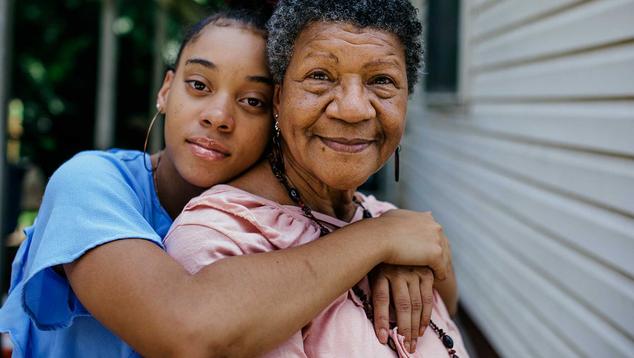Story Highlights
- Lower-income Black adults have higher wellbeing than other low-income groups do
- Wellbeing advantage for Black Americans dissipates in higher-income households
- Greater income boosts wellbeing more for Hispanic and White adults
WASHINGTON, D.C. -- The wellbeing of lower-income Black Americans is higher than that of lower-income White or Hispanic Americans, but the advantage fades among higher-income racial subgroups.
Among those in lower-income households (with annual incomes under $36,000), 46% of Black adults report high satisfaction with their current lives, slightly higher than for White (42%) or Hispanic (40%) adults from the same income group. In contrast, among those earning $120,000 or more, 80% of Black respondents rate their lives highly, compared with 86% of White and 84% of Hispanic adults.
As such, Black respondents from the higher-earning households have a 34-percentage-point advantage in their life satisfaction over their counterparts from the lower-income households, a statistically smaller gap than the 44-point difference found among both White and Hispanic respondents.
| Total | <$36k | $36k- <$60k |
$60k- <$90k |
$90k- <$120k |
$120k+ | Gap* | |
|---|---|---|---|---|---|---|---|
| % | % | % | % | % | % | pct. pts. | |
| CURRENT LIFE SATISFACTION | |||||||
| Black adults | 61 | 46 | 53 | 67 | 68 | 80 | 34** |
| White adults | 71 | 42 | 60 | 71 | 77 | 86 | 44 |
| Hispanic adults | 61 | 40 | 51 | 60 | 70 | 84 | 44 |
| ANTICIPATED LIFE SATISFACTION | |||||||
| Black adults | 68 | 55 | 62 | 76 | 76 | 81 | 26** |
| White adults | 66 | 44 | 55 | 63 | 72 | 80 | 36 |
| Hispanic adults | 62 | 46 | 52 | 66 | 66 | 81 | 35 |
| * Gap between top and bottom income groups ** Statistically significantly smaller (p<.05) than for the other two groups |
|||||||
| Gallup, Aug. 5-29, 2021 | |||||||
Anticipated life satisfaction in five years follows a similar pattern. Among lower-income households, Black adults have greater optimism for the future than do White or Hispanic adults. By contrast, there is no difference in life expectations by racial groups among respondents in households earning $120,000 or more per year.
These results are a part of the ongoing research by the Gallup Center on Black Voices that reveals trends and insights on the experiences of Black Americans.
The current report is based on web interviews collected Aug. 5-29, 2021, with 13,098 U.S. adults, using the Gallup Panel, a probability-based, non-opt-in panel of about 115,000 adults across all 50 states and the District of Columbia and a specially purchased list from Dynata.
Daily Sadness and Worry Lower Among Lower-Income Black Adults
In addition to general life ratings, Gallup tracks whether Americans experience significant levels of specific emotions, including stress and worry, in their daily lives.
Black Americans in households earning under $36,000 per year are less likely to report they experienced significant worry or sadness the day before than are their White or Hispanic counterparts. While higher-income adults of all racial groups are less likely to report these emotions, the within-race/ethnicity change by income is less pronounced for Black adults than for White or Hispanic adults.
Daily worry is particularly notable, with 47% of Black adults in lower-income households reporting worry, compared with 57% of White adults and 66% of Hispanic adults. Among those in households earning $120,000 or more, all three groups have identical estimates of 30%. As such, the reduction along the income gradient among Hispanic respondents (36 points) is more than double that of Black respondents (17 points).
| Total | <$36k | $36k- <$60k |
$60k- <$90k |
$90k- <$120k |
$120k+ | Gap* | |
|---|---|---|---|---|---|---|---|
| % | % | % | % | % | % | pct. pts. | |
| SADNESS A LOT OF PREVIOUS DAY | |||||||
| Black adults | 26 | 38 | 24 | 18 | 26 | 18 | -20** |
| White adults | 24 | 42 | 27 | 21 | 19 | 18 | -24 |
| Hispanic adults | 30 | 47 | 28 | 27 | 29 | 21 | -26 |
| WORRY A LOT OF PREVIOUS DAY | |||||||
| Black adults | 38 | 47 | 45 | 29 | 37 | 30 | -17** |
| White adults | 36 | 57 | 38 | 35 | 30 | 30 | -27 |
| Hispanic adults | 45 | 66 | 44 | 47 | 45 | 30 | -36 |
| * Gap between top and bottom income groups ** Statistically significantly smaller (p<.05) than for the other two groups |
|||||||
| Gallup, Aug. 5-29, 2021 | |||||||
Physical and Career Wellbeing Higher Among Lower-Income Black Adults
Gallup assesses people's wellbeing, more broadly, by measuring five dimensions of their experiences that add up to a thriving life:
- Career wellbeing: You like what you do every day.
- Social wellbeing: You have meaningful friendships in your life.
- Financial wellbeing: You manage your money well.
- Physical wellbeing: You have energy to get things done.
- Community wellbeing: You like where you live.
The same race/income pattern observed with life satisfaction and emotions is seen for some of the wellbeing elements.
Black Americans with lower annual household incomes (less than $36,000 per year) report significantly higher levels of physical ("My physical health is near perfect") and career ("I like what I do every day") wellbeing than do White or Hispanic Americans in the same income band.
But these racial differences dissipate among those with incomes in the $60,000 to (under) $90,000 range. Agreement with having nearly perfect health rises greatly among White respondents as income increases, whereby an 11-point deficit relative to Black respondents in lower-income households is exchanged for a six-point advantage among those living in households earning at least $120,000, a 17-point swing.
For liking what you do each day, a six-point advantage for Black adults over Hispanic adults in lower-income households is swapped for a seven-point deficit in the higher-income bracket, a 13-point swing.
This pattern is also found to a less pronounced degree for the remaining three elements when Black adults are compared with White adults, but not with Hispanic respondents.
| Total | <$36k | $36k- <$60k |
$60k- <$90k |
$90k- <$120k |
$120k+ | Gap* | |
|---|---|---|---|---|---|---|---|
| % | % | % | % | % | % | pct. pts. | |
| HEALTH NEAR PERFECT | |||||||
| Black adults | 42 | 38 | 43 | 38 | 47 | 49 | 11** |
| White adults | 42 | 27 | 31 | 39 | 43 | 55 | 28 |
| Hispanic adults | 35 | 24 | 33 | 38 | 43 | 40 | 16 |
| LIKE WHAT I DO | |||||||
| Black adults | 56 | 46 | 54 | 60 | 61 | 70 | 24** |
| White adults | 65 | 42 | 59 | 64 | 69 | 77 | 35 |
| Hispanic adults | 58 | 40 | 51 | 61 | 60 | 77 | 37 |
| * Gap between top and bottom income groups ** Statistically significantly smaller (p<.05) than for the other two groups |
|||||||
| Gallup, Aug. 5-29, 2021 | |||||||
Implications
Household income has long been understood to have a positive relationship with various aspects of wellbeing, including life ratings and daily emotional experiences as well as physical health and healthy behaviors. Income relates closely to aspects of life that can greatly influence wellbeing, including issues of basic access such as having health insurance and being able to afford healthcare. And low income has been shown to relate to obesity more strongly than "food deserts."
Past research has shown that Black Americans report higher anticipated life satisfaction five years in the future, but that this optimism is more likely to go unmet than is true for White or Hispanic Americans. Other research has revealed that general life ratings of young Black males are far lower than those of young males of a different race or ethnicity, a bigger deficit than for most other age groups. What has been less closely examined, however, is a detailed view of wellbeing across income bands through the lens of race and ethnicity.
The wellbeing advantage measured among Black Americans in lower-income households may partly be a result of Joe Biden's election to the U.S. presidency in November 2020. Recent research has shown an improvement in general life ratings among Black, White and Hispanic adults between October 2020 and June 2021, and a particular improvement among Democrats. During this time, the life ratings of Americans in lower-income households also improved substantially, while those in higher-income households were unchanged. As such, the combination of racial identity and lower income may be exhibiting a cumulative effect that was not observed in higher-income Black households at the time of this survey. By December 2021, life ratings among U.S. adults had retreated about four points from their June high, including a three-point drop among Black adults. But the boost among lower-income Americans remained elevated, suggesting that findings from this survey likely remain largely intact.
To stay up to date with the latest Gallup News insights and updates, follow us on Twitter.
Learn more about how the Gallup National Health and Well-Being Index works.
Learn more about how the Gallup Panel works.




